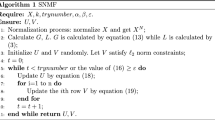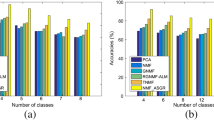Abstract
In unsupervised learning, symmetric nonnegative matrix factorization (NMF) has proven its efficacy for various clustering tasks in recent years, considering both linearly and nonlinearly separable data. On the other hand, block-wise weighted sparse representation-based classification (BW-SRC), a recently proposed sparse representation technique improved sparse coding features for supervised classification. In this work, we take advantage of both techniques to device a new unsupervised image clustering algorithm. A disadvantage of symmetric NMF is its computational burden associated to the quadratic growth of its similarity matrix. We reduce this computation by first working with sub-sampled data and then by working with the full data samples in a second stage elastic-net coefficient estimation problem with previously learned block-wise weights. This decreases both the computational time and the memory requirements when solving for symmetric NMF, but at the same time allows to cluster the full data samples in a robust way. We either outperform or achieve highly competitive results with previous matrix factorization clustering methods on seven benchmark image datasets.










Similar content being viewed by others
References
Ramirez I, Sprechmann P, Sapiro G (2010) Classification and clustering via dictionary learning with structured incoherence and shared features. In: 2010 IEEE Computer Society conference on computer vision and pattern recognition, pp 3501–3508
Xu J, Xu K, Chen K, Ruan J (2015) Reweighted sparse subspace clustering. Comput Vis Image Underst 138:25–37. https://doi.org/10.1016/j.cviu.2015.04.003
Zhang R, Lu Z (2016) Large scale sparse clustering. In: Proceedings of the twenty-fifth international joint conference on artificial intelligence, IJCAI’16. AAAI Press, pp 2336–2342
Feng X (2018) Spectral clustering via sparse representation. IntechOpen. https://doi.org/10.5772/intechopen.76586
Dong W, Wu XJ, Kittler J, Yin HF (2019) Sparse subspace clustering via nonconvex approximation. Pattern Anal Appl 22:165–176. https://doi.org/10.1007/s10044-018-00774-z
Kuang D, Yun S, Park H (2015) SymNMF: nonnegative low-rank approximation of a similarity matrix for graph clustering. J Glob Optim 62:545–574. https://doi.org/10.1007/s10898-014-0247-2
Meng Y, Shang R, Jiao L, Zhang W, Yuan Y, Yang S (2018) Feature selection based dual-graph sparse non-negative matrix factorization for local discriminative clustering. Neurocomputing 290:87–99. https://doi.org/10.1016/j.neucom.2018.02.044
Zhu Z, Li X, Liu K, Li Q (2018) Dropping symmetry for fast symmetric nonnegative matrix factorization. In: Proceedings of the 32nd international conference on neural information processing systems, NIPS’18. Curran Associates Inc., Red Hook, NY, USA, pp 5160–5170
Wei L, Zhou R, Zhu C, Zhang X, Yin J (2020) Adaptive graph-regularized fixed rank representation for subspace segmentation. Pattern Anal Appl 23:443–453. https://doi.org/10.1007/s10044-019-00786-3
Liu H, Shao M, Li S, Fu Y (2016) Infinite ensemble for image clustering. KDD ’16. Association for Computing Machinery, New York, pp 1745–1754. https://doi.org/10.1145/2939672.2939813
Huang D, Wang C, Lai J (2018) Locally weighted ensemble clustering. IEEE Trans Cybern 48(5):1460–1473
Huang D, Wang C, Wu J, Lai J, Kwoh C (2020) Ultra-scalable spectral clustering and ensemble clustering. IEEE Trans Knowl Data Eng 32(6):1212–1226
Zhou W, Zhou Q (2019) Deep embedded clustering with adversarial distribution adaptation. IEEE Access 7:113801–113809
Feng Q, Chen L, Chen CLP, Guo L (2020) Deep fuzzy clustering-a representation learning approach. IEEE Trans Fuzzy Syst 28(7):1420–1433
Chang J, Meng G, Wang L, Xiang S, Pan C (2020) Deep self-evolution clustering. IEEE Trans Pattern Anal Mach Intell 42(4):809–823
Niu C, Zhang J, Wang G, Liang J (2020) Gatcluster: self-supervised gaussian-attention network for image clustering. In: Vedaldi A, Bischof H, Brox T, Frahm JM (eds) Computer vision—ECCV 2020. Springer International Publishing, Cham, pp 735–751
Rodríguez-Domínguez U, Dalmau O (2020) Block-wise weighted sparse representation-based classification. Signal Image Video Process. https://doi.org/10.1007/s11760-020-01700-9
Wright J, Yang AY, Ganesh A, Sastry SS, Ma Y (2009) Robust face recognition via sparse representation. IEEE Trans Pattern Anal Mach Intell 31(2):210–227. https://doi.org/10.1109/TPAMI.2008.79
Zou H, Hastie T (2005) Regularization and variable selection via the elastic net. J R Stat Soc Ser B (Stat Methodol) 67(2):301–320
Lovász L, Plummer M (2009) Matching theory, vol 367. AMS Chelsea Publishing, New York
Gong B, Shi Y, Sha F, Grauman K (2012) Geodesic flow kernel for unsupervised domain adaptation. In: 2012 IEEE conference on computer vision and pattern recognition, pp 2066–2073. https://doi.org/10.1109/CVPR.2012.6247911
Samaria FS, Harter AC (1994) Parameterisation of a stochastic model for human face identification. In: Proceedings of 1994 IEEE workshop on applications of computer vision, pp 138–142 https://doi.org/10.1109/ACV.1994.341300
Lecun Y, Bottou L, Bengio Y, Haffner P (1998) Gradient-based learning applied to document recognition. Proc IEEE 86(11):2278–2324. https://doi.org/10.1109/5.726791
Li Fei-Fei, Fergus R, Peron P (2004) Learning generative visual models from few training examples: an incremental Bayesian approach tested on 101 object categories. In: 2004 conference on computer vision and pattern recognition workshop, pp 178–178 https://doi.org/10.1109/CVPR.2004.383
Donahue J, Jia Y, Vinyals O, Hoffman J, Zhang N, Tzeng E, Darrell T(2014) Decaf: a deep convolutional activation feature for generic visual recognition. In: Proceedings of the 31st international conference on international conference on machine learning, ICML’14, vol 32. JMLR.org, pp I-647–I-655
Russakovsky O, Deng J, Su H, Krause J, Satheesh S, Ma S, Huang Z, Karpathy A, Khosla A, Bernstein M, Berg AC, Fei-Fei L (2015) ImageNet large scale visual recognition challenge. Int J Comput Vis (IJCV) 115(3):211–252. https://doi.org/10.1007/s11263-015-0816-y
Tian F, Gao B, Cui Q, Chen E, Liu TY (2014) Learning deep representations for graph clustering. In: Proceedings of the twenty-eighth AAAI conference on artificial intelligence, AAAI’14. AAAI Press, pp 1293–1299
Liu H, Liu T, Wu J, Tao D, Fu Y (2015) Spectral ensemble clustering. In: Proceedings of the 21th ACM SIGKDD international conference on knowledge discovery and data mining, KDD ’15. Association for Computing Machinery, New York, NY, USA, pp 715–724. https://doi.org/10.1145/2783258.2783287
Shao M, Li S, Ding Z, Fu Y (2015) Deep linear coding for fast graph clustering. In: Proceedings of the 24th international conference on artificial intelligence, IJCAI’15. AAAI Press, pp 3798–3804
Acknowledgements
This work was supported partly by CONACYT (Mexico) Grant 258033.
Author information
Authors and Affiliations
Corresponding author
Additional information
Publisher's Note
Springer Nature remains neutral with regard to jurisdictional claims in published maps and institutional affiliations.
Rights and permissions
About this article
Cite this article
Rodríguez-Domínguez, U., Dalmau, O. Symmetric nonnegative matrix factorization with elastic-net regularized block-wise weighted representation for clustering. Pattern Anal Applic 25, 807–817 (2022). https://doi.org/10.1007/s10044-022-01062-7
Received:
Accepted:
Published:
Issue Date:
DOI: https://doi.org/10.1007/s10044-022-01062-7




